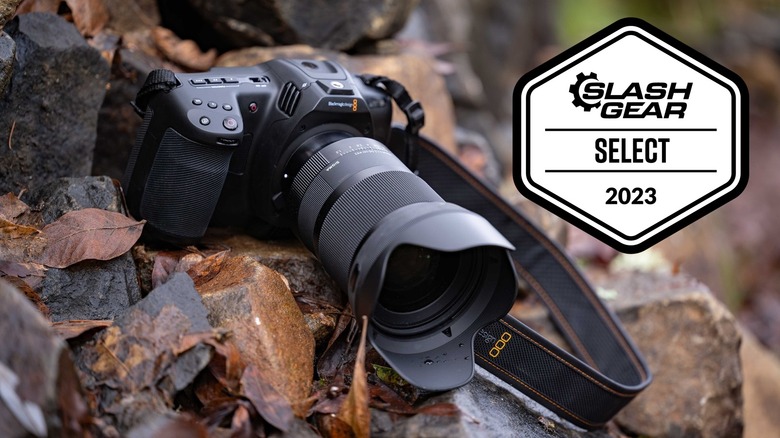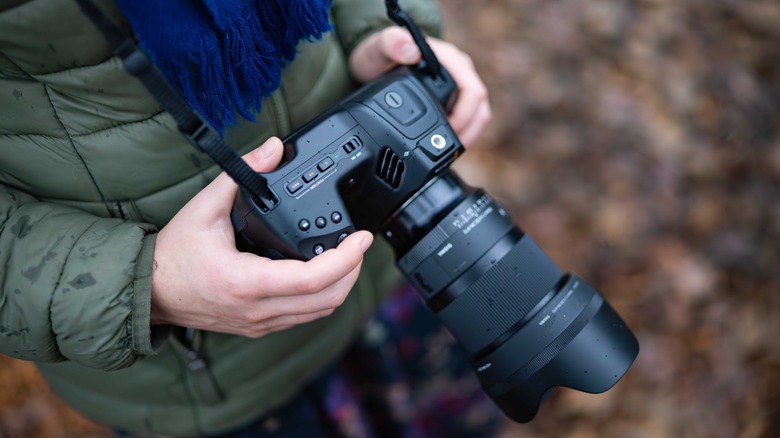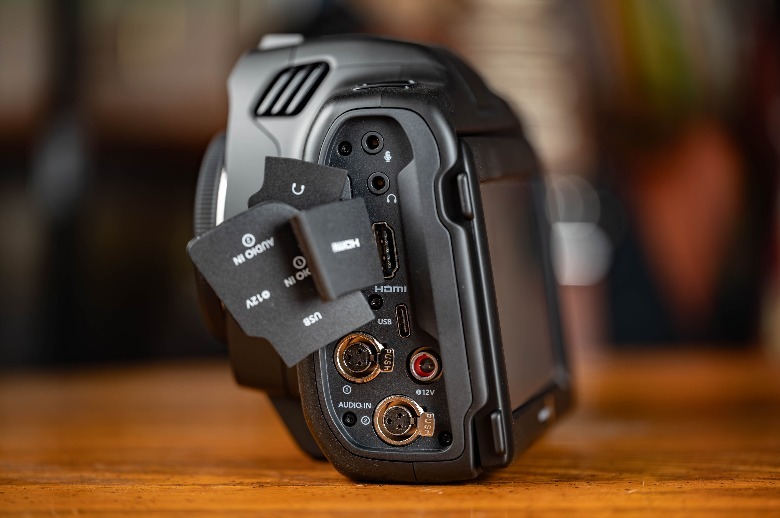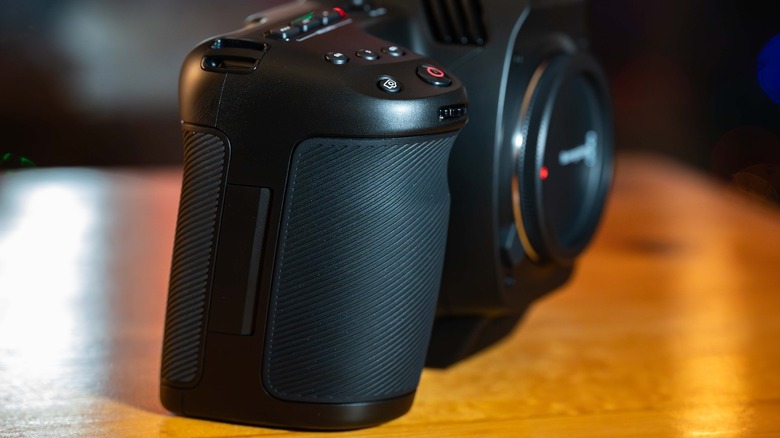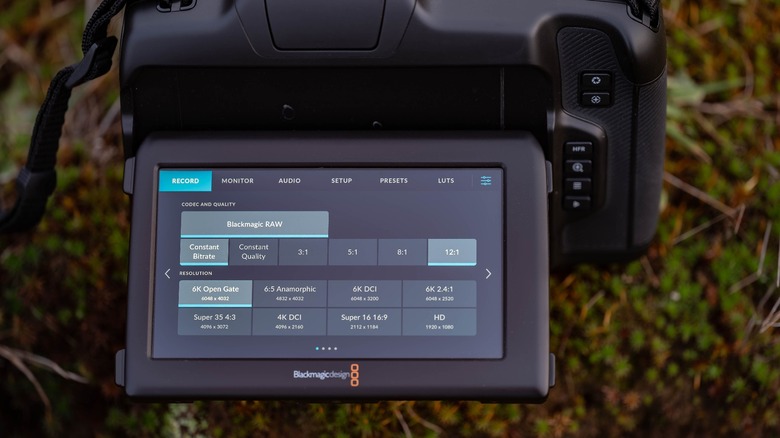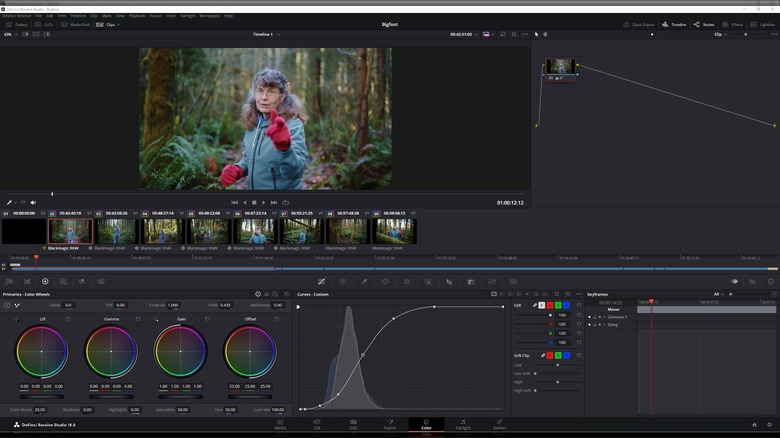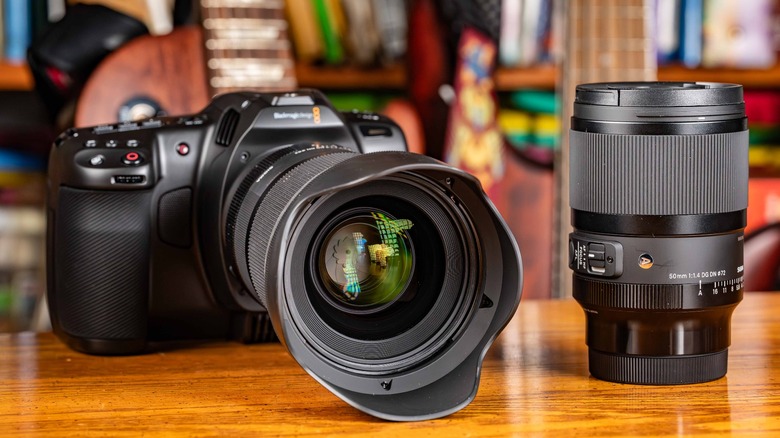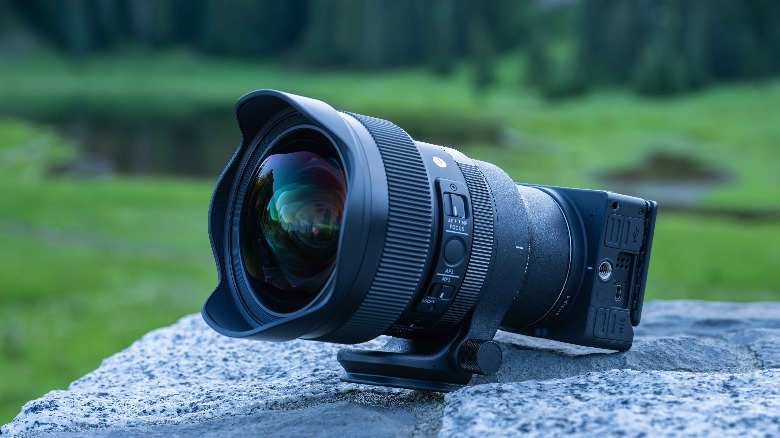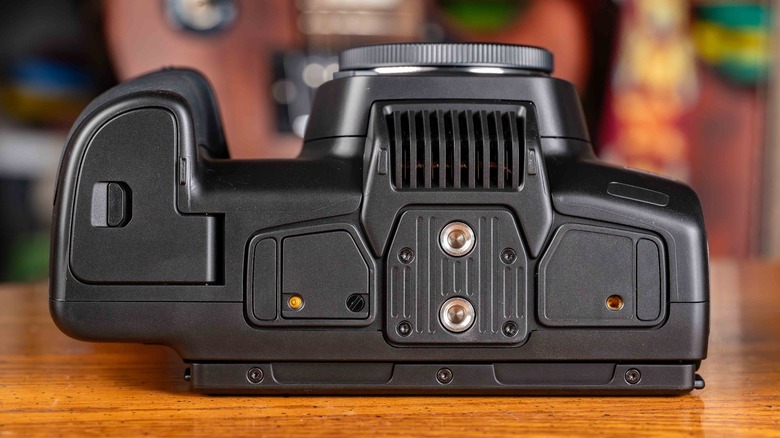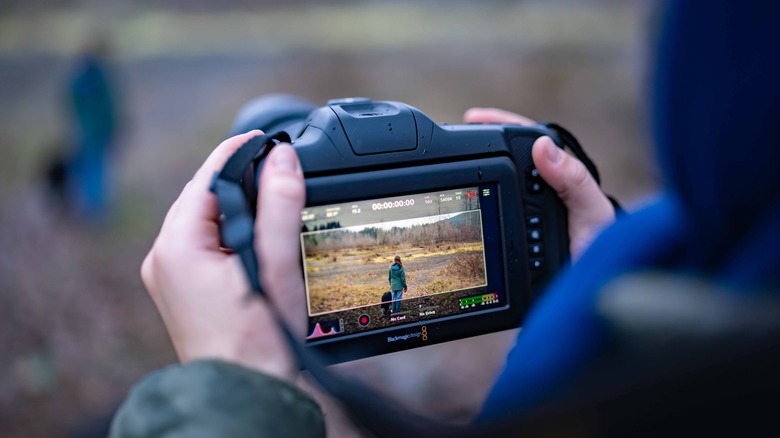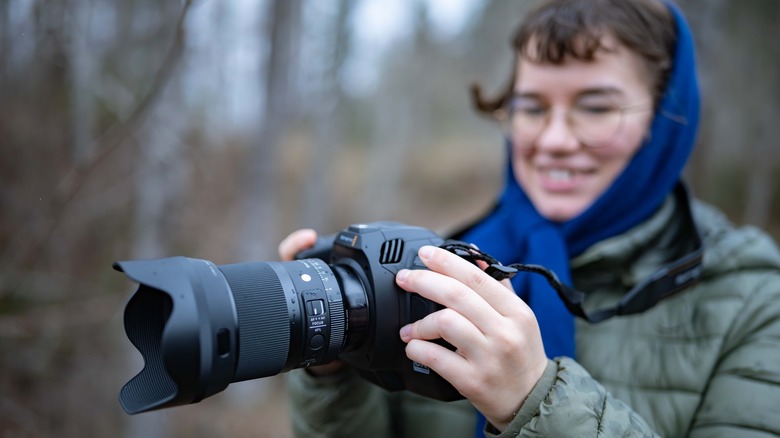Blackmagic Cinema Camera 6K Review: Affordable L-Mount Filmmaking Achieved
- Full frame sensor delivers gorgeous video footage
- Blackmagic RAW codec is wonderful to work with
- L-mount lens compatibility has a vast array of options
- Enormous, bright touchscreen display
- Solidly built
- Numerous ports and mounting brackets
- Relatively cheap for a cinema camera
- Camera saves gyro data for image stabilization in post-processing
- DaVinci Resolve Studio included
- Professional cinematography features
- Excellent onboard audio recording capability
- Big and bulky
- Not water resistant
- No IBIS
- Abysmal battery life
- Blackmagic RAW files require a lot of storage
- Significant learning curve
The Blackmagic Cinema Camera 6K presents a familiar face to those knowledgeable of Blackmagic's line of budget-friendly cameras, and even its name may seem confusingly similar to previous products from this manufacturer. However, this appears to be a true example of why you should never judge a book by its cover, as the BMCC6K has some serious upgrades under the hood.
It's important to note that this is a very different beast from your typical DSLR or mirrorless camera designed to shoot stills and video. The Blackmagic Cinema Camera 6K is, as its name implies, designed very specifically for shooting professional-grade video footage, so your experience with more mass-market devices will only partly carry over. There's a significant learning curve for newcomers to such cameras, and that's the perspective from which we will approach this review. With that in mind, our testing largely consisted of shooting and editing a few skits, which have been included below.
Blackmagic provided a sample of the Cinema Camera 6K for the purposes of the review. Sigma also provided L-mount samples of its 35mm f/1.2 DG DN Art and 50mm f/1.4 DG DN Art to use with the Cinema Camera 6K.
On the chunky side
The first thing we noticed after taking the Blackmagic Cinema Camera 6K out of the box was how much larger it was than we had imagined. It makes the hefty Nikon Z9 look almost petite by comparison, and as this bulk is concentrated in a tremendously long and wide right-hand grip, it is rather tricky to use with some camera gimbals. We tried it out on a DJI Ronin S, but mounting was a real challenge, and proper balancing was impossible. If we were to get the right adaptors, however, we could probably make it work.
Moving behind the sheer size of the BMCC6K, we found both familiar camera characteristics and some more unusual design features. We appreciated how big and comfortable the grip is, with a very comfortable grooved rubber coating. The large button, which on a hybrid camera would be to trigger the shutter, starts video recording. Another thing that takes getting used to is that for autofocus you press the corresponding button on the back of the camera rather than half-pressing the shutter. Physical controls in general are rather sparse, and instead, you'll be mostly interacting with the gigantic 5-inch touch display which features a robust articulation mechanism.
It's important to note that this camera is not water resistant, so you'll want to avoid using it in the rain or other situations where it may become damp. However, it's also quite solidly built and holds up fine to use out in the field.
Video quality fit for the big screen
As it says in the name, this camera shoots 6K footage, and while you're unlikely to actually produce content at its full 6048 x 4032 resolution, those extra pixels are really useful in post-processing. It allows for a lot of flexibility in the editing room, and it looks great downsampled to 4k or 1080p. Paired with the excellent glass that Sigma sent us to test, the Blackmagic Cinema Camera 6K delivered some absolutely amazing results.
The BMCC6K shoots in Blackmagic RAW video format, which is perhaps the best RAW video codec we've used. The file size is enormous of course, but we were surprised by how easy it was to work with. Blackmagic RAW delivers an incredible degree of latitude when post-processing, with dark shadows and bright highlights both beautifully preserved.
In terms of noise, the Blackmagic Cinema Camera 6K handles low-light situations very well, thanks to its dual-native ISOs of 400 and 3200. We did a lot of filming indoors and at night without extra lighting, and got excellent results. Of course, shooting with an F/1.2 lens certainly helped in this regard.
Gyro sensor helps fill in for lack if IBIS
The lack of in-body stabilization (IBIS) in the Blackmagic Cinema Camera 6K is definitely something those used to modern mirrorless cameras may raise an eyebrow at. It has become such a standard feature that we take it for granted. It's a very handy feature that works quietly behind the scenes to improve our photos and videos and is even commonly found in smartphones. However, stabilizing the full-frame sensor in the Blackmagic Cinema Camera 6K would have meant jacking up the price, and maybe compromising on portability and battery life as well – areas in which this camera can ill-afford to further disadvantage itself. Therefore, the lack of IBIS is perfectly understandable.
In its place is a gyro sensor, which records the motion of the camera and then embeds it into videos. Using Davinci Resolve Studio, you are then able to apply stabilization after the fact in post-processing your footage. It's very similar to what GoPro does with cameras such as the Hero 12 Black. In the Blackmagic Cinema Camera 6K, this method works well much of the time, at least in decent light without strong, violent motion. It works nearly as well as mechanical IBIS systems when applied to less extreme scenarios, but in poor light and with more significant motion it can struggle or fail altogether.
While gyro stabilization in post isn't a complete replacement for IBIS, we can't help but wish that all cameras collected gyro data for a little extra boost to stabilization.
Impressive onboard audio and IO
We were surprised by how well the built-in microphones and amp perform. The bigfoot mockumentary we filmed for this review was recorded entirely using the onboard microphones, and the results are impressive in their rendering of vocals and ambient sound, as well as the low self-made noise of the camera itself. The large, front-facing dual microphones are a huge upgrade over the built-in mics on other cameras we've used.
However, unless you're as absentminded as we are and forget your audio gear at home, you're likely to be using an external microphone. Here the Blackmagic Cinema Camera 6K certainly has you covered, as it features a fairly comprehensive IO panel on the side. In addition to the typical 3.5mm jacks for mics and headphones, there are also two mini XLR ports with support for phantom power, meaning that you can plug high-end mics directly into the camera. The audio inputs can also be used for timecode input.
Additionally, the Blackmagic Cinema Camera 6K includes full-size HDMI, USB-C, and 12V power ports. For internal memory, the camera accepts CFExpress cards, and can also record to external solid-state drives.
Pitiful battery life and memory hogging files aren't the end of the world here
The BMCC6K uses the widely available np-f570 battery, meaning that it's easy to find affordable spare batteries. That's a good thing since the Blackmagic Cinema Camera 6K suffers from regrettably abysmal battery life. We had to recharge it after only short filming sessions, so you're going to want more than a few extra batteries in your bag.
Fortunately, thanks to its 12V 2-pin locking connector port, the Cinema Camera 6K can be powered from an external power source. Alternatively, you could pick up the battery grip accessory for the BMCC6K, which advertises a claimed 3 hours of continuous video recording.
The camera also is something of a storage hog thanks to those 6K RAW video files, so you'll probably also want to record to an external SSD rather than a pricey CFExpress card.
Learning an unfamiliar user interface
We're most accustomed to using cameras from Nikon, Canon, Sigma, and Sony, which while all very different, are still reasonably easy to swap between and not be too lost. The Blackmagic Cinema Camera 6K however is a different kettle of fish. This is an interface that's very much from the world of cinema and is very focused on that niche. As a result, it's somewhat alien to those more used to jack-of-all-trades cameras.
With that said, it's all very well designed, and within a few weeks of filming with the BMCC6K we felt fairly confident with its operation. Our muscle memory developed to deal with the unfamiliar button layout, and we eventually came to appreciate the on-screen settings and menu system. Thanks to the large screen, switching settings around is much more convenient and fluid than on other cameras with smaller screens. While typically we prefer having tactile, physical controls, Blackmagic has managed to make this touchscreen a good alternative.
That screen deserves special mention, as it is certainly bright and beautiful, and the size of it means that you don't need a separate monitor for the camera. Grabbing accurate manual focus was never a problem, and it's been hard to go back to composing our shots on the smaller screens of other cameras.
Professional video editing software included
The Blackmagic Cinema Camera 6K comes packaged with a free copy of the premium version of Blackmagic's own DaVinci Resolve Studio video editing software. Resolve is an excellent alternative to Adobe Premiere Pro which is also available in a surprisingly capable free version, and which doesn't force users to pay for a pricey subscription. While we've used Resolve in the past, we're much more familiar with Premiere Pro, but we nonetheless had little difficulty in jumping back into Resolve as part of this review.
The first thing we noticed was how much more efficient Resolve is the Premiere Pro. Importing videos and scrubbing through clips was fluid and lag-free, something which we struggle with in Premiere Pro, even on a powerful modern desktop rig. The color editing interface is a breath of fresh air as well, and professional quality effects are easy to implement in your video.
Including the premium Resolve Studio with the Blackmagic Cinema Camera 6K was a great move, as it pairs perfectly with the camera. Our experience was so good that we may very well go ahead and cancel our Adobe Premiere Pro subscription and make the permanent switch to Resolve.
The strength of the L-mount alliance
The Cinema Camera 6K marks Blackmagic's entry into the L-mount alliance, an ever-expanding group of companies building cameras and lenses around a common lens mount standard. These include manufacturers such as Leica, Sigma, and Panasonic, and the result after years of collaborative work is an immense ecosystem of compatible photography gear. This means that if you already own a camera such as the high resolution, photography-focused Sigma FP-L, and want to pick up the Blackmagic Cinema Camera 6K to capture video, then all your lenses will carry over to the BMCC6K.
The lineup of available L-mount lenses is quite impressive and fits a wide range of budgets and use cases. Sigma sent over a few of their fantastic prime lenses to test with the Blackmagic camera, and both delivered great image quality. We were particularly enamored with the 35mm f/1.2 DG DN Art lens, which enabled us to keep ISO levels low even in extremely low light conditions and delivered razor-sharp details paired with an ocean of creamy bokeh. Earlier in 2023 we also tested the Sigma 14mm f/1.4 DG DN Art lens, another example of a lens that would pair nicely with the BMCC6K.
Being part of the L-mount alliance gives end users plenty of choice and the security of buying into an ecosystem that isn't bound to the fortunes of a single company.
Some accessories required
While the Blackmagic Cinema Camera 6K is perfectly capable of functioning as an all-in-one minimalist video creation rig, it really benefits from the addition of first and third-party accessories. Blackmagic sells an electronic viewfinder separately, as well as a battery grip. Furthermore, as previously mentioned, an external battery bank and solid-state drive are really helpful when shooting with this camera. Also, the lack of a cold or hot shoe means there's a good chance you will at least want to add this option.
The BMCC6K has been built with this expandability in mind, as it features not one, but two quarter-inch screw mounts below, and one in the place where you would normally expect a hot shoe to be. A great way to start expanding the Cinema Camera 6K would be to get a camera cage such as those offered by Smallrig, and build out there.
Cinema camera on a budget
The Blackmagic Cinema Camera 6K starts at $2,595, which while certainly not an inconsequential sum, is nonetheless a mere fraction of what many professional cinema cameras cost. For example, Blackmagic's own Ursa Mini Pro 4.6k G2 will set you back $5,995, and it features a relatively small Super 35mm sensor. That camera certainly features plenty of reasons for those who can afford it to make the step up, such as built-in optical ND filters, but for the filmmaker on the budget, the Cinema Camera 6K offers amazing value for money. Alternatively, the older and more affordable Pocket Cinema Cameras from Blackmagic are good, cheaper options, but they also have smaller sensors.
Additionally, from a value perspective, the use of the L-mount in the BMCC6K means there are some great lenses available at very reasonable prices for the system. The Sigma 35mm f/1.2 DG DN Art and 50mm f/1.4 DG DN Art lenses we tested clock in at $1,499, and $849 respectively, which both offer great value compared to other brands, and there's a wide range of even more affordable lens options from Sigma and other members of the L-mount alliance. At the high end, the scale goes all the way up to $14,000 glass from Atlas lenses.
Conclusion
Despite dealing with a significant learning curve upon first picking up the Blackmagic Cinema Camera 6K, we soon grew to love this budget-friendly filmmaking monster of a camera. For a full-frame camera with such impressive capabilities, it is remarkably affordable. This camera, and the Sigma lenses we tested with it, inspired us to get out and film the two short films included in this review, goofy as those skits may be. Capturing such gorgeous footage on such an expansive screen with its well-designed interface truly does make you want to go out and create things.
There are a lot of little things we found to nitpick about this camera, such as how its enormous bulk made it incompatible with the gimbal we had available at the time, but at this price point, such quibbles are the sort of sacrifices you've got to expect. At the end of the day, this is a camera you could use to shoot a feature film at a similar price point to a mid-range hybrid mirrorless camera. That alone makes the Blackmagic Cinema Camera 6K easy to recommend.
You can find the Blackmagic Cinema Camera 6K for sale on Amazon for approximately $2,595 right now.
